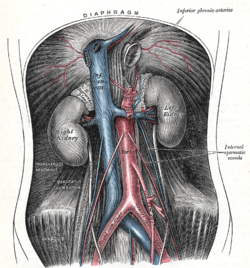- Organ of Zuckerkandl
-
Organ of Zuckerkandl 
The abdominal aorta and its branches. (Organ of Zuckerkandl is not shown, but it usually appears alongside the abdominal aorta.) The Organ of Zuckerkandl is a chromaffin body derived from neural crest located at the bifurcation of the aorta or at the origin of the inferior mesenteric artery. It can be the source of pheochromocytoma.[1]
The term "paraaortic bodies" is also sometimes used to describe it, as it usually arises near the abdominal aorta, but this term can be the source of confusion, because the term "corpora paraaortica" is also used to describe the aortic body, which arises near the thoracic aorta.
Contents
Function
Its physiological role is thought to be of greatest importance during the early gestational period as a homeostatic regulator of blood pressure, secreting catecholamines into the fetal circulation.
The organ itself regresses in the late third trimester and following birth to form the aorticosympathetic group of the adult paraganglia.
Pathology
It can be the source of paraganglioma.[2]
The Organ of Zuckerkandl is of pathological significance in the adult as a common extra-adrenal site of pheochromocytoma though the most common extra-adrenal site is in the superior para-aortic region between the diaphragm and lower renal poles. [3]
Extra-adrenal tumors account for around 10% of all cases of pheochromocytoma.[4] Resection has been described.[5]
In addition to its endocrine effects, it can also cause obstructive pathology.[6]
Eponym
This diffuse group of neuroendocrine sympathetic fibres was first described by Emil Zuckerkandl, a professor of anatomy at the University of Vienna, in 1901.[7]
Nomenclature
Some sources equate the "aortic bodies" and "paraaortic bodies",[8] while other sources explicitly distinguish between the two.[9][10] When a distinction is made, the "aortic bodies" are chemoreceptors which regulate circulation, while the "paraaortic bodies" are the chromaffin cells which manufacture catecholamines.
References
- ^ Dossett LA, Rudzinski ER, Blevins LS, Chambers EP (September 2007). "Malignant pheochromocytoma of the organ of Zuckerkandl requiring aortic and vena caval reconstruction". Endocr Pract 13 (5): 493–7. PMID 17872352. http://aace.metapress.com/openurl.asp?genre=article&issn=1530-891X&volume=13&issue=5&spage=493.
- ^ Saurborn DP, Kruskal JB, Stillman IE, Parangi S (2003). "Best cases from the AFIP: paraganglioma of the organs of Zuckerkandl". Radiographics 23 (5): 1279–86. doi:10.1148/rg.235035022. PMID 12975514. http://radiographics.rsnajnls.org/cgi/pmidlookup?view=long&pmid=12975514.
- ^ Whalen RK, Althausen AF, Daniels GH. Extra-adrenal pheochromocytoma. J Urol. 1992 Jan;147(1):1-10. Review. PubMed PMID: 1729490
- ^ http://content.nejm.org/cgi/content/extract/346/19/1486
- ^ Kravarusic D, Pinto-Rojas A, Al-Assiri A, Sigalet D (October 2007). "Laparoscopic resection of extra-adrenal pheochromocytoma--case report and review of the literature in pediatric patients". J. Pediatr. Surg. 42 (10): 1780–4. doi:10.1016/j.jpedsurg.2007.06.025. PMID 17923216. http://linkinghub.elsevier.com/retrieve/pii/S0022-3468(07)00443-5.
- ^ Blecha M, Galanopolous C, Dharkar D, Salti G (September 2005). "Massive organ of Zuckerkandl inducing small bowel obstruction". J. Am. Coll. Surg. 201 (3): 480–1. doi:10.1016/j.jamcollsurg.2005.02.031. PMID 16125084. http://linkinghub.elsevier.com/retrieve/pii/S1072-7515(05)00257-7.
- ^ synd/3111 at Who Named It?
- ^ "organs of Zuckerkandl" at Dorland's Medical Dictionary
- ^ MeSH Aortic+Bodies
- ^ MeSH Para-Aortic+Bodies
External links
- 00520 at CHORUS
- paraaortic+bodies at eMedicine Dictionary
Human anatomy, endocrine system: endocrine glands (TA A11, TH H3.08, GA 11.1269) Islets of pancreas Hypothalamic/
pituitary axes
+parathyroidPituitaryPars intermedia · Pars tuberalis · Pars distalis
Acidophil cell (Somatotropic cell, Prolactin cell) · Basophil cell (Corticotropic cell, Gonadotropic cell, Thyrotropic cell) · Chromophobe cellThyroid isthmus · Lobes of thyroid gland · Pyramidal lobe of thyroid gland
Follicular cell · Parafollicular cellPineal gland Other 
This anatomy article is a stub. You can help Wikipedia by expanding it.
